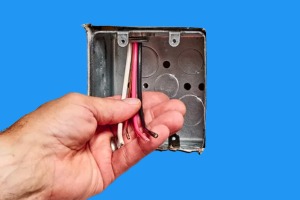
The use of three wires to wire a 220V dryer outlet began in the 1960s. These wires include two hot wires (black and red), and one wire that serves both as ground and neutral wire.
The wiring system worked well and is still in use in many homes today. However, there is a greater risk of electrical shock since the ground and neutral wire are the same.
In 1996; the National Electrical Code (NEC) requirement changed. The new outlets now come with 4 prongs and wires. Dryer cords and most 220 v power tools also come with 4 prongs to comply with the code.
Importance of wiring a 220V plug with 4 wires
Wiring a 220v outlet with 4 wires helps in the following ways:
Safety: Now that 220 outlets have separate wires for load, neutral and ground, chances of ground fault and electrocution have reduced.
Compatibility with modern appliances: Most modern appliances such as dryers and ovens require a 4-wire connection to work properly. Wiring a 220-volt plug with 4 wires ensures compatibility with those modern devices.
Compliance with electrical codes: In most regions, it is required by law to wire 220 plugs with four wires in order to meet electrical safety codes and regulations.
Required tools and materials
- Screwdriver
- Wire stripper
- Needle nose plier
- Flash touch
- Voltage tester
Materials
- Electrical box
- 4 prong dryer outlet
- 10-3 NM cable with ground wire
- 30 amp double pole circuit breaker
Steps to wiring a 220 volt plug with 4 wires
Mount the outlet box and run the cable

In a house without a dryer outlet before, the first thing you should do is to mark out a place to install the wall outlet.
Depending on your choice of wiring, you can either continue with surface wiring or conduit.
In surface wiring, the wire is usually laid on the wall surface, and may be covered with trunk pipe.
But in conduit, you crack the wall, lay the PVC pipe, and then draw the cable through the conduit pipe to the main circuit breaker box.
Note: The wire must be a 10-3 NM cable with ground wire.
Connect the earth wire to the green terminal

The outlet usually comes with 4 terminals, two brass terminals, one green and one silver terminal.
Connect the bare copper wire or green insulated ground wire to the green screw of the outlet and tighten it.
Connect the two hot wires

Strip about 3/4 inches of insulation from the red and black wires and secure each of them to the brass terminals of the outlet.
Connect the neutral wire.
Strip out about 3/4 inches of insulators from the white wire and connect it to the silver colored or neutral terminal of the outlet. Tighten the screw to hold the wire in position.
Secure the outlet on the metal box
Insert the outlet into the metal box and carefully push the wires inside. Secure the outlet on the box and cover it.
Time to install the 30 amp double pole breaker
Once you finish installing the 220-volt outlet, proceed to your main breaker panel and turn off the power.
Loosen the screws holding the panel cover and remove it to expose the wiring.
Test the branch circuits using your multimeter to confirm the power is off. You can do this by placing one probe of the tester on the screw terminal of the breaker, and the other probe on the ground bus bar.
Note: The incoming cables from the service lines are live wires. Do not touch any of them to avoid electrocution.
Look for an empty slot in the panel where you will mount the breaker and remove the slot tab.
Open a knock out on one side of the panel and pass the cable through it. Use a clamp to hold the wires in place.
Connect the neutral wire to its slot
Insert the white wire into the neutral bus bar and tighten the screw. Fold the remaining wire and tuck it along the panel.
Note: The neutral bus bar and the ground bus bar are always the same in every breaker, except in the sub-panel. The sub-panels usually have a separate neutral bus bar from the ground bus bar.
Connect the ground or green wire to its bus bar
Connect the ground or green wire from the 220 outlet to the ground bus bar.
You can do that by inserting the bare wire into the ground bus bar and securing the wire with a screw.
Connect the two hot wires
Connect the black and red wires from the outlet to screw terminals of the 30 amp breaker and tighten the screw. Carefully fold the remaining wire and keep it at the side of the panel.
Install the circuit breaker
Once you are through with the connection, gently mount the breaker. Make sure the clip slides over the mounting hook on the hot bush bar. Press down on the breaker until it snaps into place.
Reinstall the panel cover
Cover the electrical panel and tighten it with screws. Switch off all the branch breakers in the panel and turn on the main breaker, then switch on each of the branch circuits, one at a time, to prevent power surge.
Test the outlet
Use your voltage tester to confirm that the outlet is having light.
Conclusion
4 wire outlets are beneficial to our homes as they help prevent ground faults, electric shocks and other hazards.
However, it is purely the work of an electrician who understands NEC codes, wire gauges and electrical safety.
Frequently Asked Questions
What are the 4 wires on a 220 plug?
The 4 wires on a 220 plug are: Two load wires (black and red wire), one white or neutral wire and a bare copper wire, or green ground wire.
What color is 220 4-wires?
The colors of the 220 4-wires are black, red, white, and green or naked wire.
How do you wire a 4-wire to a 3-wire?
You can wire a 4-wire to 3-wire by connecting the two hot wires to the hot or brass terminals, and connecting the neutral wire to the silver terminal.
The earth wire should be disconnected from the breaker board.
What is the difference between 3 and 4 wires?
The difference between the 3 and 4 wire system is that in 3 wire systems, the outlet makes use of three wires, two hot and one wire that serve both as neutral and ground.
This 3 wire system increases the risk of electric shock and other hazards.
While in 4 wire systems, the system has separate wires for ground and neutral. This 4-wire system is safe and also reduces loss of electricity.
Does the 3 wire 220 have ground?
The 3 wire 220 outlet doesn’t have a ground wire. They usually have two load wires and another single wire that serve both as a neutral and ground wire.
What is the difference between a 220v outlet and a 240v outlet?
The main difference between a 220 volt and a 240 volt is the amount of current they can carry.
A 220 volt circuit supplies twice the amount of current a 120v circuit can supply, while a 240 circuit supplies 10% more than a 220v circuit.
Related articles